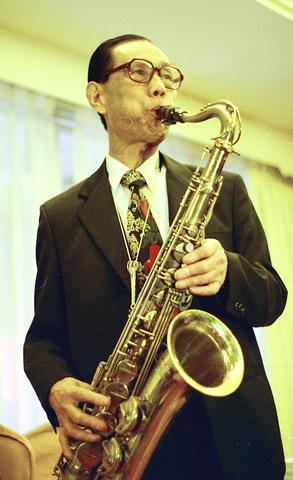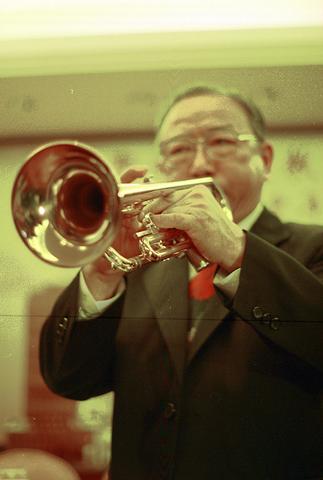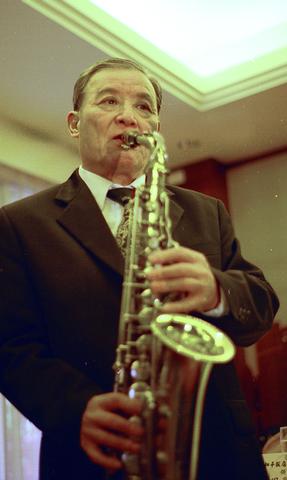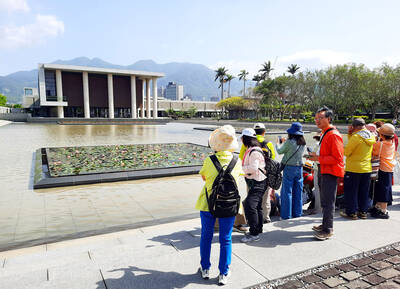Shanghai in the 1930s was an Asian version of F Scott Fitzgerald's jazz age, flush with money, the thrill of new music, dangerous women and political intrigue. And the focus of much of this activity was the Peace Hotel along the Bund, the Ritz or Waldorf-Astoria of pre-war Shanghai.
Few hotels have such a vaunted place in the history of a city as the Peace Hotel (

PHOTO: IAN BARTHOLOMEW
The Peace Hotel continues to operate as one of Shanghai's top ranking hotels, and in addition to its historical architectural interest, a draw for many visitors to the city is the Peace Hotel jazz band, a group of septuagenarian musicians who are a living link with Shanghai's jazz heyday. The group is visiting Taiwan for a series of concerts in Taichung at the invitation of the Lien Jade Peace Cultural and Education Foundation (

PHOTO: IAN BARTHOLOMEW
While Summertime and Moonlight Serenade are hardly listed among the highest achievements of jazz composition, the six-man band has its own unique appeal, delighting even younger generations of visitors to the Peace Hotel. Having lived through one of the most tumultuous centuries in Chinese history, they seem to retain a quality of innocence and delight in the music they play, which is a joy to watch.
"Mostly we were amateur jazz musicians," said Zhou Wanrong (

PHOTO: IAN BARTHOLOMEW
His face wrinkles with merriment as he recalls the 1930s and 1940s when he and other members of the band played at clubs like the Paramount. "Many people [from our generation] in Taiwan still remember it," he said. Ironically, it was the imminent arrival of the Japanese that gave Zhou and his colleagues their big break.

PHOTO: IAN BARTHOLOMEW
"Before [the Japanese push south], most of the bands in Shanghai were foreigners," he said. "There were lots of Filipino bands playing the big hotels and dance venues. Chinese only played in small bars and clubs." But as the Japanese approached Shanghai, the foreign bands pulled out, "and to keep the business going, managers had no option but to hire Chinese." The demands of western consular presence also produced a demand for Zhou's services. "When they had a parade, we became a marching band; when they held a ball, we put together a big band of nine or 10."
Zhou and other members of the Peace Hotel jazz band found a ready audience in the US troops after the war, who were happy to be regaled with the hits by Glenn Miller, Louis Armstrong and Benny Goodman. "There weren't many people like us," Zhou said. "So we drew good salaries. We were paid in US dollars."
Zhou said that he and other band members took part in various classical orchestras as part of China's cultural diplomacy, playing for former US presidents Jimmy Carter and Ronald Reagan, Queen Elizabeth and numerous other heads of state.
In 1980, when the decadence of jazz became acceptable again, the Peace Hotel brought Zhou and other veterans of the jazz scene together to form its own jazz band. Since then, they have gone from strength to strength, their blend of music and nostalgia becoming all the more appealing as Shanghai reemerges, after decades of cultural and economic repression, as a vibrant regional center.
Who: The Shanghai Peace Hotel Jazz Band (上海和平飯店老年爵士樂團)
When: Dec. 30 - Jan.4
Where: Main Hall, Lien Jade Peace Building (聯聚和平大廈), 111-18, Wen-hsin Rd., Sec. 2, Taichung (台中市文心路二段111-18號)
Tickets: Free. Only a limited number of places remain available. For performance times and bookings, contact tel: (04) 258-9988

When the South Vietnamese capital of Saigon fell to the North Vietnamese forces 50 years ago this week, it prompted a mass exodus of some 2 million people — hundreds of thousands fleeing perilously on small boats across open water to escape the communist regime. Many ultimately settled in Southern California’s Orange County in an area now known as “Little Saigon,” not far from Marine Corps Base Camp Pendleton, where the first refugees were airlifted upon reaching the US. The diaspora now also has significant populations in Virginia, Texas and Washington state, as well as in countries including France and Australia.

On April 17, Chinese Nationalist Party (KMT) Chairman Eric Chu (朱立倫) launched a bold campaign to revive and revitalize the KMT base by calling for an impromptu rally at the Taipei prosecutor’s offices to protest recent arrests of KMT recall campaigners over allegations of forgery and fraud involving signatures of dead voters. The protest had no time to apply for permits and was illegal, but that played into the sense of opposition grievance at alleged weaponization of the judiciary by the Democratic Progressive Party (DPP) to “annihilate” the opposition parties. Blamed for faltering recall campaigns and faced with a KMT chair

Article 2 of the Additional Articles of the Constitution of the Republic of China (中華民國憲法增修條文) stipulates that upon a vote of no confidence in the premier, the president can dissolve the legislature within 10 days. If the legislature is dissolved, a new legislative election must be held within 60 days, and the legislators’ terms will then be reckoned from that election. Two weeks ago Taipei Mayor Chiang Wan-an (蔣萬安) of the Chinese Nationalist Party (KMT) proposed that the legislature hold a vote of no confidence in the premier and dare the president to dissolve the legislature. The legislature is currently controlled

Dull functional structures dominate Taiwan’s cityscapes. But that’s slowly changing, thanks to talented architects and patrons with deep pockets. Since the start of the 21st century, the country has gained several alluring landmark buildings, including the two described below. NUNG CHAN MONASTERY Dharma Drum Mountain (法鼓山, DDM) is one of Taiwan’s most prominent religious organizations. Under the leadership of Buddhist Master Sheng Yen (聖嚴), who died in 2009, it developed into an international Buddhist foundation active in the spiritual, cultural and educational spheres. Since 2005, DDM’s principal base has been its sprawling hillside complex in New Taipei City’s Jinshan District (金山). But